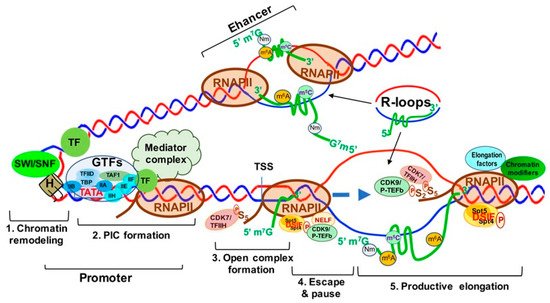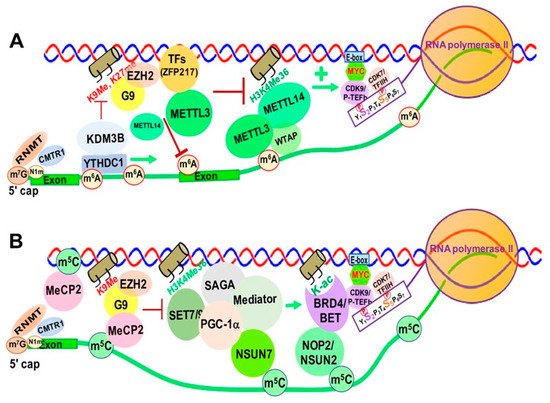3.1. m6A and RMPs Modulate Interactions between Non-Coding RNAs, Transcription Factors and Chromatin Modifiers
The METTL3/14 methyltransferases, YTH-domain-containing proteins (YTHDs)/HNRNPs, and FTO/ALKB family proteins function as m
6A writers, readers and erasers, respectively, to regulate the level and distribution of m
6A in a tissue-/differentiation-specific manner
[62][63][64][65][66] (A). Recent studies have shown widespread m
6A in human tissues, which is significantly enriched in long intergenic non-coding RNA (lincRNA) and CpG-rich gene promoters, suggesting that m
6A is positively correlated with gene expression homeostasis and has broad involvement in human development and disease
[67].
Increasing evidence suggests that m
6A and its associated RMPs, more specifically m
6A writers and readers, modulate chromatin structure and transcriptional activation through interactions with TFs and chromatin modifying proteins/complexes
[68][69]. METTL14 was reported to recognize the active histone mark H3K36me3, resulting in METTL3-METTL14-WTAP m
6A methyltransferase complex recruitment to the vicinity of H3K36me3 peaks, promoting m
6A and positively regulating transcription elongation
[70] (A).
Figure 3. RNA Modification/RMP-mediated, Transcription-associated Chromatin Structural Changes in Mammalian Cells. (A). m6A and its RMPs-mediated chromatin structural changes. (B). m5C and its RMPs-mediated chromatin structural changes. Abbreviations: m6A, N6-methyladenine; RNMT, RNA Methyltransferase; CMTR1, cap methyltransferase 1; KDM3B, lysine demethylase 3B; YTHDC1, YTH Domain Containing 1; EZH2, enhancer of Zeste 2 Polycomb repressive Complex 2 Subunit; METTL3/14, methyltransferase Like 3/14; K9me, lysine 9 methyl; K27me, lysine 27 methyl; TFs, Transcription Factors; ZFP217, zinc finger Protein 217; H3K4me36, histone 3 lysine 36 tri-methylation; E-box, enhancer box; CDK9/P-TEFb, cyclin-dependent kinase 9; CDK7/TFIIH, cyclin-dependent kinase 7. m5C, 5-methylcytosine; MeCP2, methyl-CpG binding protein 2; SET7/9, SET Domain containing 7/9 histone lysine methyltransferase; SAGA, Spt-Ada-Gcn5-acetyltransferase; PGC-1α, peroxisome proliferator-activated receptor γ coactivator 1-α; NSUN7, NOP2/Sun RNA methyltransferase member 7; H3K4me36, histone 3 lysine 36 tri-methylation; NOP2/NSUN1, NOP2 nucleolar protein/NOP2/Sun RNA methyltransferase 1; K-ac, lysine acetylation; BRD5/BET, bromodomain containing 4; E-box, enhancer box; CDK9/pTEFb, cyclin-dependent kinase 9; CDK7/TFIIH, cyclin-dependent Kinase 7; MYC, MYC proto-oncogene BHLH transcription factor.
Zinc finger protein 217 (ZFP217), a chromatin-associated oncogenic TF important for embryonic stem cell (ESC) differentiation
[71], is associated with repressive chromatin marked by histone 3 lysine 9 trimethylation (H3K9me3) and histone 3 lysine 27 trimethylation (H3K27me3) through interactions with G9a and EZH2 methyltransferases
[8]. ZFP217 also negatively affects m
6A deposition at its own target gene mRNAs by sequestering METTL3 in an inactive status, in which METTL3 is dissociated from the METTL14/WTAP co-factor complex
[71][72] (A).
YTHDC1 can de-repress (activate) gene expression by physically interacting with and recruiting KDM3B demethylase to hyper-m
6A in nascent RNAs, leading to demethylation of the repressive transcriptional histone modification H3K9me2
[73]. YTHDC1 can also facilitate the decay of a subset of these m
6A-modified RNAs, especially LINE-1, through nuclear exosome targeting-mediated nuclear degradation, while METTL3 deposits m
6A modifications on chromosome-associated regulatory RNAs (carRNAs), including promoter-associated RNAs, enhancer RNAs and repeat RNAs
[74].
m
6A was reported to promote translation of the SETD1A/B components, which increases the transcriptional activation histone mark H3K4me3 and recruitment of the erythroid-specific zinc finger transcription factor KLF1 to its target gene promoters
[75]. Inhibition of the METTL3/METTL14/WTAP m
6A methyltransferase complex blocks erythropoiesis in human bone marrow hematopoietic stem/progenitor cells (HSPCs). The METTL3-METTL14-WTAP complex also functionally interacts with SMAD2/3 proteins, the key signal transducers and transcriptional modulators of the TGFβ pathway. SMAD2/3 promotes binding of the m
6A methyltransferase complex to a subset of transcripts involved in early cell fate decisions
[76]. In addition, a recent study showed that RBM15, a subunit of the m
6A methyltransferase complex, mediates the degradation of the pre-BAF155 mRNA to affect the chromatin remodeling function of the BAF (SWI/SNF-like) complex
[77].
3.2. The Impact of m5C and Its RMPs on Chromatin and Transcription
In eukaryotes, RNA m
5C is catalyzed by RCMTs, including NOL1/NOP2/SUN domain (NSUN) family enzymes and DNMT2 (B). NSUN2 is responsible for catalyzing the majority of m
5C in mRNAs and non-coding RNAs
[78][79][80]. Our study demonstrated a marked increase in NOP2/NSUN1 and NSUN2-mediated m
5C in drug (5-azacitidine) resistant myeloid leukemia cells
[60]. NSUN7 is reported to promote transcription of genes labeled with enriched m
5C eRNAs in mouse hepatoma cells and primary hepatocytes for adaptive metabolic responses
[76]. Mechanistically, the methyltransferase SET7/9 methylates histone 3 K4 residues
[77] and PGC-1α K779, a transcriptional co-activator important for regulating adapted metabolic responses
[81]. Methylated PGC-1α interacts with Spt-Ada-Gcn5-acetyltransferase (SAGA) and mediator complexes, as well as NSUN7, at the m
5C-marked enhancer RNAs of PGC-1α target genes to promote recruitment of transcription machinery and reinforce transcription of those genes ().
Heterozygous mutations in the X-linked gene encoding MeCP2 cause the neurological disorder Rett syndrome. MeCP2 interacts with more than 40 binding partners, including transcriptional regulators, chromatin modifiers and RNA- splicing factors
[82]. MeCP2 chromatin binding is controlled by m
5C, and recent studies show enrichment of MeCP2 on long non-coding RNAs (lncRNAs), such as retinal noncoding RNA3 (RNCR3)
[83], muscle-specific long non-coding RNA (ChRO1)
[84], and major Satellite Forward RNAs
[85]. This MeCP2 enrichment on lncRNAs promotes deposition of H3K9me3 and H4K20me3 and heterochromatin formation. Additionally, m
5C is present in a wide variety of RNA species, including cytoplasmic and mitochondrial ribosomal RNAs (rRNAs) and tRNAs, as well as mRNAs, eRNAs and other types of non-coding RNAs
[86]. There are widespread and dynamic changes in RNA m
5C in response to stress and stimuli, which suggests an important role of m
5C and its RMPs in epigenetic gene regulation
[86]. However, the detailed mechanisms underlying m
5C and its RMP-mediated chromatin remodeling and gene regulation are yet to be elucidated.



